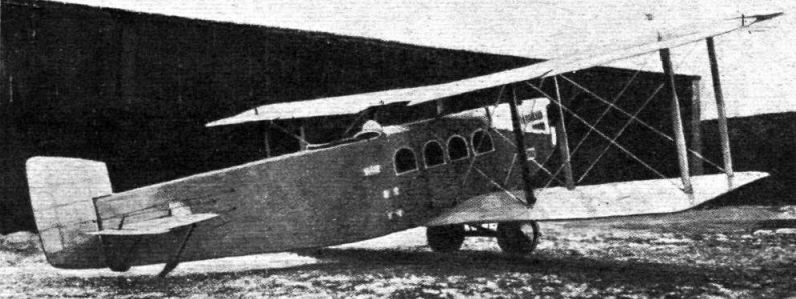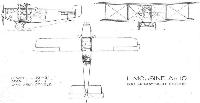Aero А. 10
Фирма "Aero Tovarna Letadel Dr Kabes" была основана в Праге в 1919 году и вначале занималась производством аксессуаров для авиационной промышленности. Вскоре после своего появления она приступила к строительству копий бипланов, разработанных фирмой "Phonix Flugzeugwerft" в Австрии. Самолеты Phonix были, в свою очередь, дальнейшим развитием машин серии Hansa-Brandenburg, созданных талантливым конструктором Эрнстом Хейнкелем. Путь от производства аэропланов зарубежного происхождения до создания собственного самолета Aero прошла очень быстро.
Одной из первых ее моделей стал Aero А. 10, примечательный тем, что оказался первым коммерческим самолетом чехословацкой постройки. А.10 был деревянной машиной с тканевой обшивкой. Его вместительный фюзеляж позволял разместиться пяти пассажирам. В передней части пассажирской кабины находилось багажное отделение, над которым в открытой кабине располагался пилот. Модель имела шестицилиндровый однорядный двигатель Maybach.
Создание прототипа началось в 1921 году, а первый полет новый аэроплан совершил в 1922 году. Следом было построено четыре самолета А.10, которые в 1924 году поступили в чешскую государственную авиакомпанию "Ceskoslovenske Aerolinie" (CSA) и использовались на маршруте Прага - Братислава.
ТАКТИКО-ТЕХНИЧЕСКИЕ ХАРАКТЕРИСТИКИ
Aero А.10
Тип: шестиместный коммерческий транспортный самолет
Силовая установка: один однорядный шестицилиндровый двигатель Maybach Mb IV мощностью 240 л. с.
Летные характеристики: максимальная скорость - 160 км/ч; крейсерская скорость - 130 км/ч; рабочий потолок - 5800 м; дальность полета - 520 км.
Масса: пустого - 1297 кг; максимальная взлетная - 2046 кг
Размеры: размах крыльев - 14,20 м; длина - 10,14 м; площадь крыльев - 51 кв. м.
Показать полностьюShow all
Flight, June 1922
A NEW CZECHOSLOVAK COMMERCIAL BIPLANE
The Limousine Ae 10
IN the first commercial aeroplane to be designed and constructed in Czecho-Slovakia this re-born country has demonstrated that, in spite of the fact that up to a few years ago its aviation industry was conspicuous for its absence, it is already capable of taking its place amongst the foremost aircraft constructing nations. This new commercial machine has just been turned out from the works of the Aero Aircraft Factory of Prague, whose designers, MM. Husnik and Vlasak, are to be congratulated in having produced a machine the general lines of which at once strike one as being both practical and pleasing to the eye.
The Limousine Ae 10 was designed to meet the needs of the growing demand for aerial intercourse with neighbouring countries, the Republic being determined to take an active part in the various aerial services running, and to be run, to and from Czecho-Slovakia. It is a tractor biplane, with a deep fuselage of good streamline form. The engine, a 260 h.p. Maybach Mb. IVa, is mounted in the nose and drives a 10 ft. 3 in. tractor screw. The radiator is mounted behind the latter, and has been found to give very satisfactory results, causing little resistance.
Behind the engine is an enclosed cabin accommodating three or five passengers, and separated from the engine compartment by a double metal-covered partition as a precaution against fire. The cabin is very roomy, well upholstered, and has double walls, ceiling and flooring, giving an exceedingly strong construction; it is also isolated and noise-proof, and so adds to the safety and comfort of the passengers. Three windows, glazed with Triplex, on each side of the cabin give a good range of vision, whilst the rear window may be used as a direct communication between the cabin and the pilot - conversationally, of course.
Access to the cabin is by means of a door on the right-hand side of the cabin. In the cabin are three comfortable seats, and two tables which are upholstered underneath, so that they can be tilted up and used as seats when two extra passengers are carried. At the rear of the cabin is a space for luggage, measuring 5 ft. 10 ins. by 3 ft. by 2 ft. Above this is the pilot's cockpit, just behind the main planes, from which an excellent view in all directions is obtained. Provision is also made for the accommodation of a navigator, who has a seat just behind the pilot, and both can easily change places if desired. A fire extinguisher, in direct communication with the engine and carburettor, is also located in this cockpit.
The main planes are in five sections, the lower in two attached direct to the fuselage, and two upper attached to a small centre section. They are set at a dihedral angle, but no sweep-back, and the top plane has a very slight overhang. Balanced ailerons are fitted to the top plane only. The main petrol tank is carried in the top centre section, whence the petrol is led by gravity through a single pipe, via a filter, direct to the carburettor. The petrol system is thus of the simplest form possible. The tank is filled by means of a special pump, and the petrol passes through a filter before entering the tank.
The tail plains are of tubular steel construction, fabric covered, and consist of an adjustable rectangular horizontal stabiliser, mounted between the upper and lower longerons just above the line of thrust, two balanced elevators hinged to the stabiliser, and a balanced rudder. No vertical fin is fitted, as the flat sides of the fuselage, which tapers to a deep vertical knife-edge, renders this unnecessary. The controls are' of the conventional type - elevator and aileron column, and rudder bar.
Special attention has been given to the undercarriage, as it was realised that many of the accidents are caused by faulty landing gear. The two wheels are of large diameter - 960 mm. - with the object of enabling the machine to land on very soft and uneven ground. They are located well forward, which has the effect of giving a quick pull up. The wheels are mounted on a divided axle, with rubber shock absorbers, which is carried by twelve steel struts, having six points of attachment to the fuselage. These struts are arranged in three pairs of "M's," when viewed from the front, as indicated in the accompanying general arrangement drawings. Landing shocks are thus well distributed over the fuselage; in places the factor of safety is about 12, both in the landing chassis and cabin. Throughout the machine double wiring is employed.
The principal characteristics of the Limousine Ae 10 are :-
Span 47 ft. 1 in.
Chord 5 ft. 9 ins.
Length 33 ft. 3 ins.
Height 11 ft. 8 ins.
Area of main planes 570 sq.ft.
Useful load (3 pass.) 1,650 lbs.
Weight, fully laden 1,620 lbs.
Weight/sq. ft. 8-2 lbs.
Weight/h.p. 17.7 lbs.
Speed 93 m.p.h.
Duration 4 hours.
Engine 260 h.p. Raybach.
Показать полностьюShow all
Flight, August 1923
GOTHENBURG International Aero Exhibition 1923
Czechoslovakia
Aero Tovarna Letadel, Prague. - This firm, of which Inz. A. Husnik is chief designer, exhibited two machines. One of these, the commercial A.10, is a cabin biplane, with 260 h.p. Maybach engine, and has seating accommodation for five passengers in the cabin and another in an open cockpit behind the pilot. The machine was described in detail in FLIGHT of June 15, 1922, and it is not, therefore, necessary to refer to its constructional features here. The machines are being used extensively on the Prague-Bratislava line, and among notable flights carried out by this type mention may be made of the flight from Prague to Mostar, Yugoslavia. The machine exhibited at Gothenburg was flown over in one day, the total flying time being 7 3/4 hours. It is of interest to mention, by way of an instance of the very lively interest taken by Czech public men in aviation, that the Minister for National Defence, Frank Udrzal, and the Minister for Public Works, Srba, each has one of the A.10 aeroplanes at his disposal, and that both do most of their travelling by air.
The main characteristics of the type A.10 are as follows: Length, o.a., 10.2 m. (33 ft. 6 ins.); span, 14.2 m. (46 ft. 7 ins.); wing area, 51 sq. m. (550 sq. ft.); weight empty, 1,455 kgs. (3,200 lbs.); useful load, 750 kgs. (1,650 lbs.); maximum speed, 140 km. (87 m.p.h.); climb to 10,000 ft. in 30 mins.; ceiling, 5,800 m. (19,000 ft.).
<...>
Показать полностьюShow all






